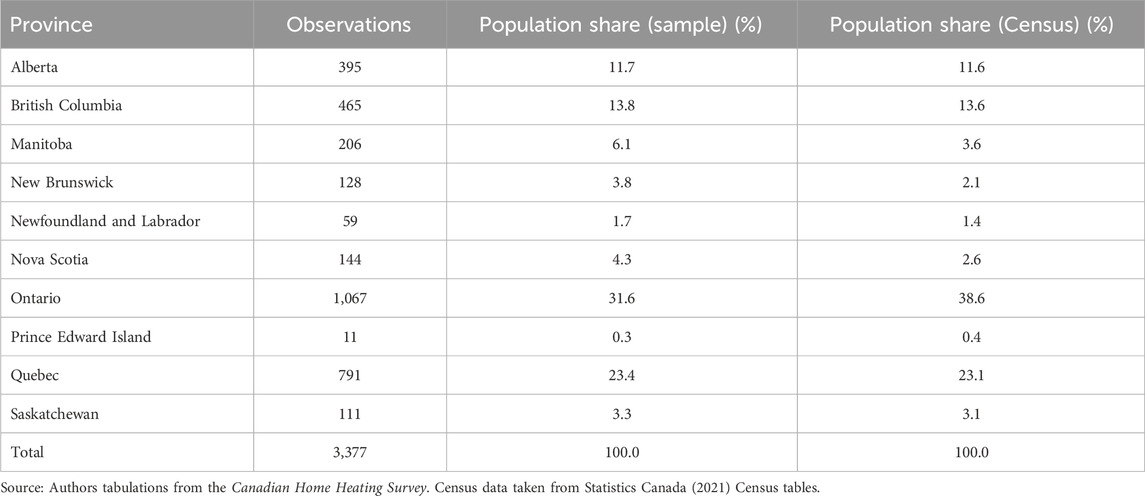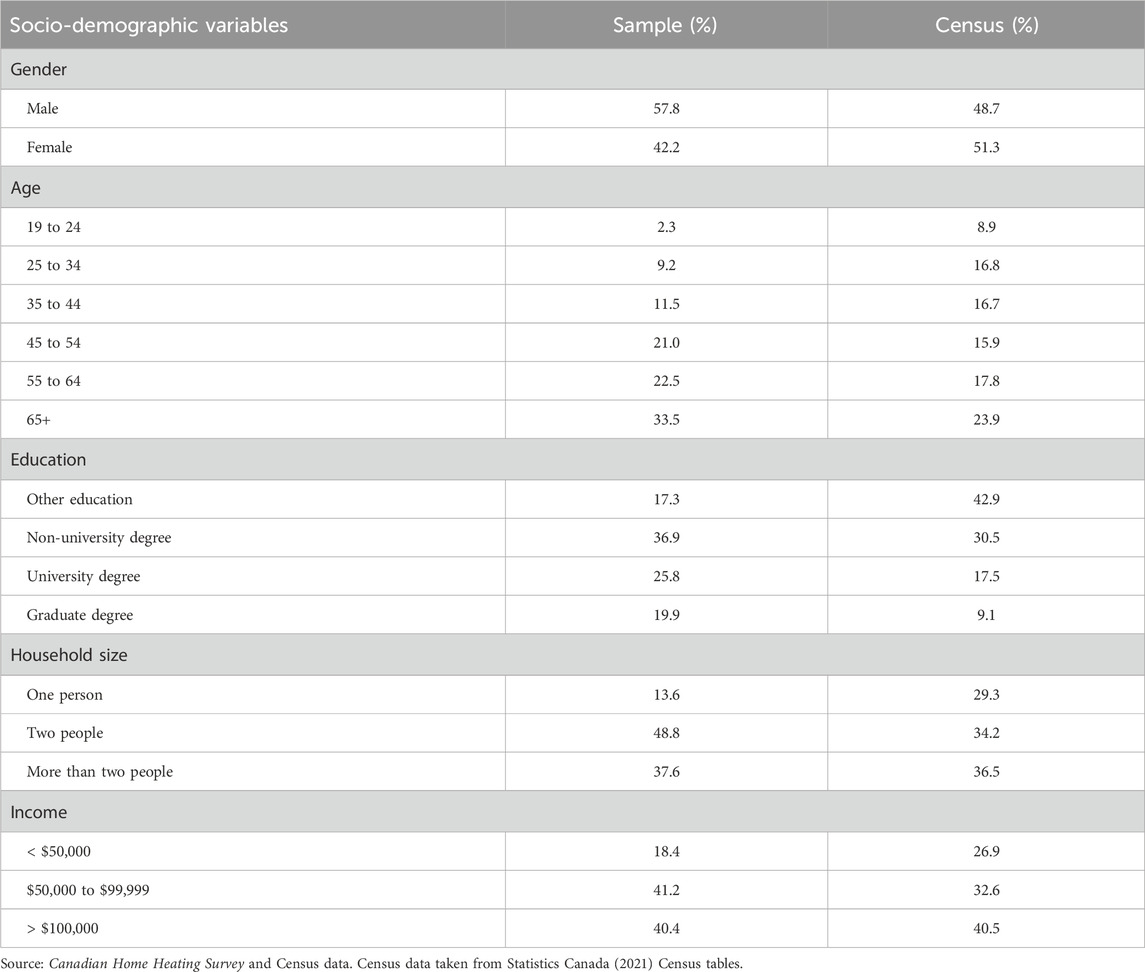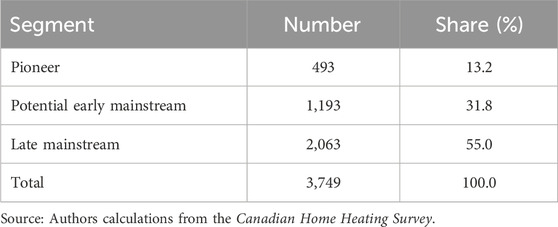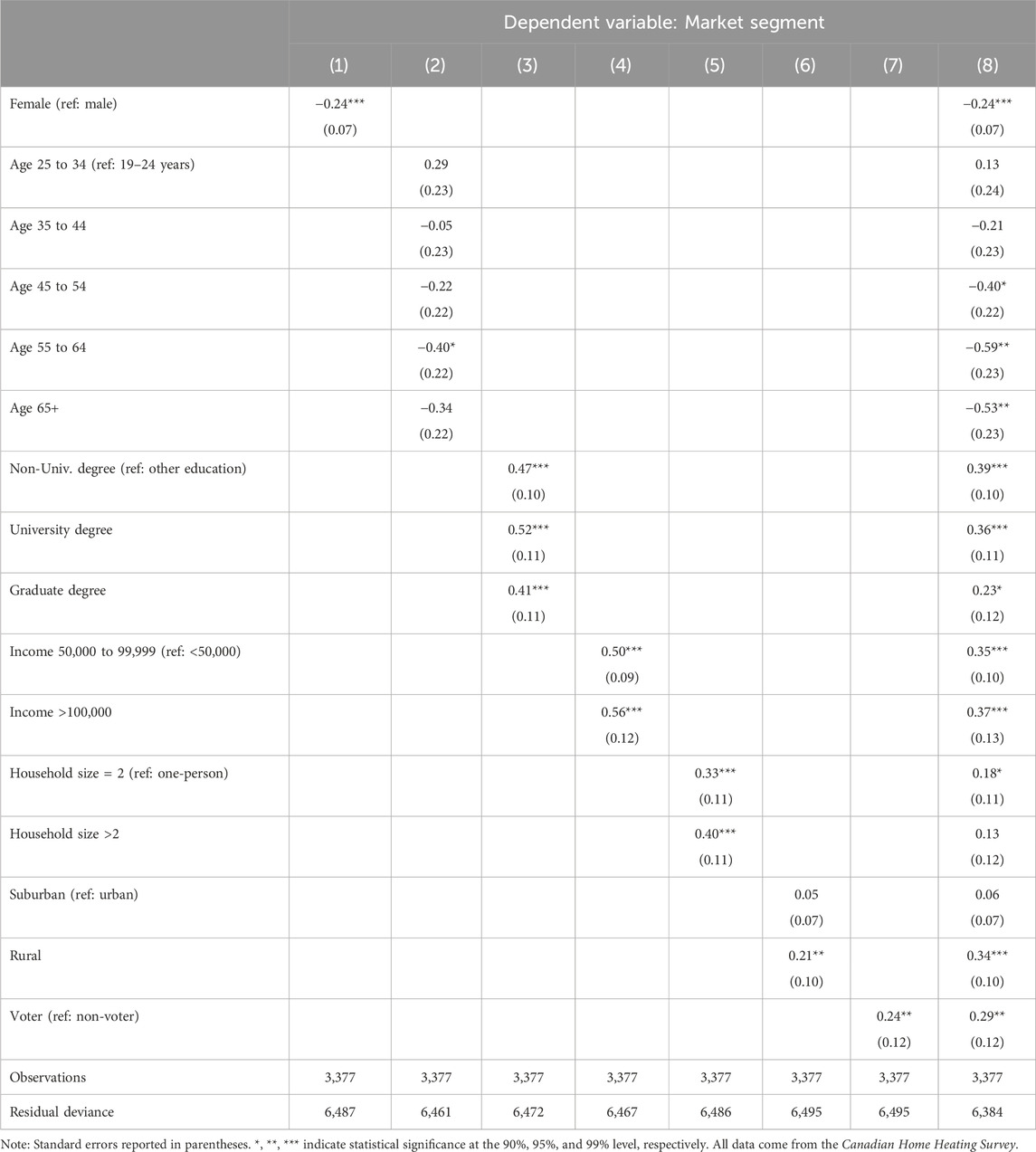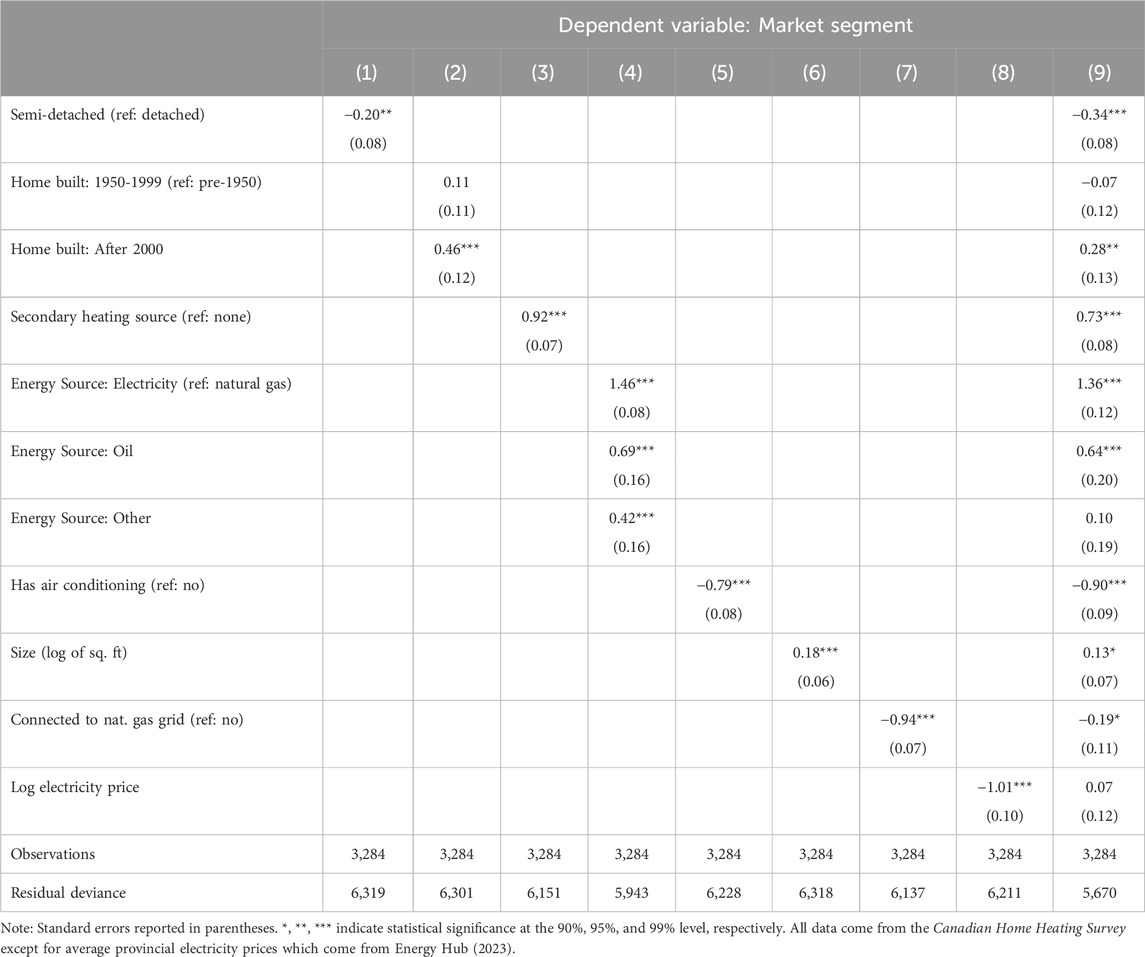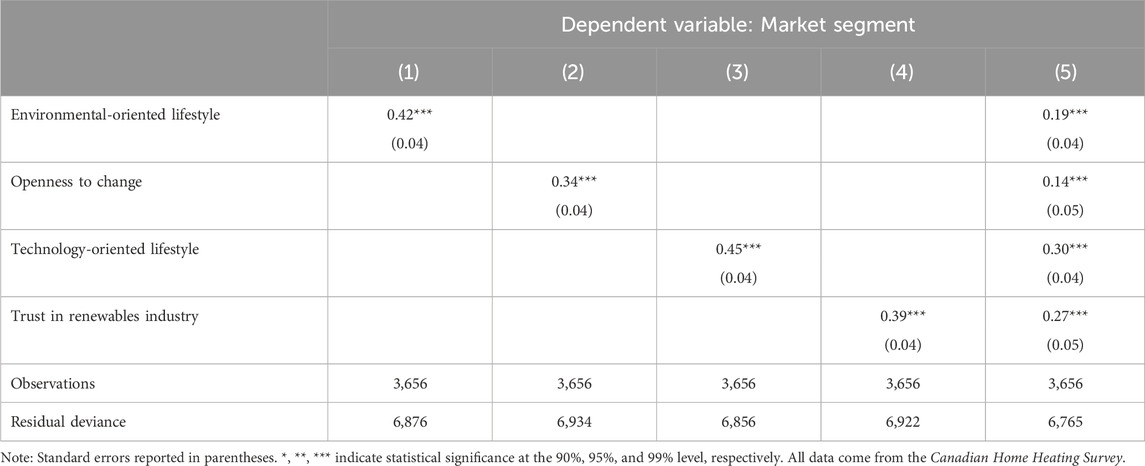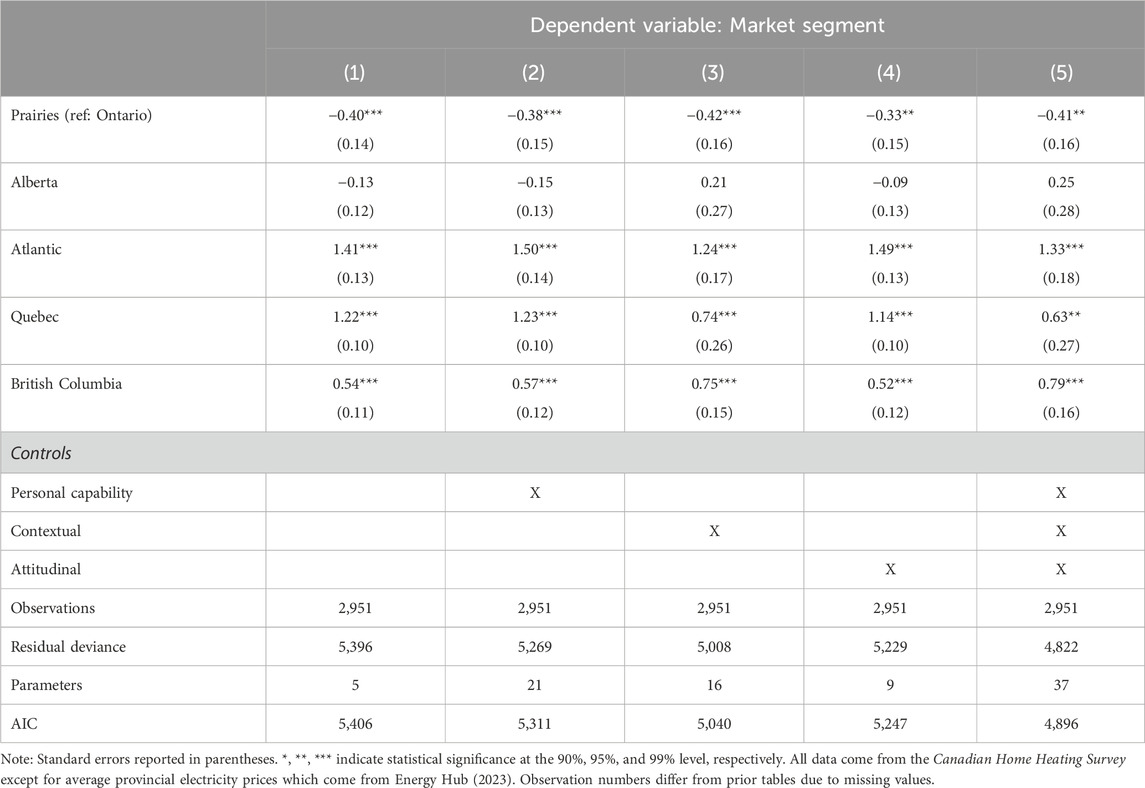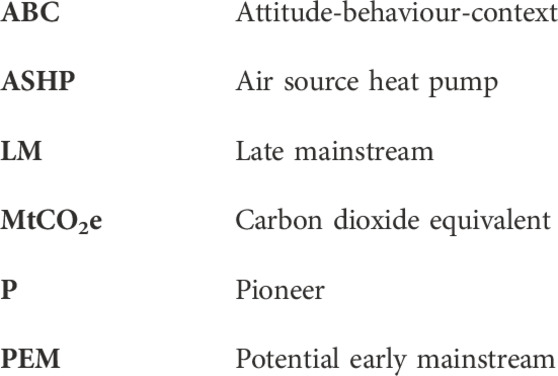The landscape of heat pump adoption in Canada: a market segments approach
- 1Institute for Integrated Energy Systems, University of Victoria, Victoria, BC, Canada
- 2School of Resource and Environmental Management, Simon Fraser University, Vancouver, BC, Canada
- 3School of Public Administration, Institute for Integrated Energy Systems, University of Victoria, Victoria, BC, Canada
Heat pumps are an important technology for reducing residential building emissions, however their adoption rate in North America is far below what is needed to meet emission reduction targets. This paper uses a representative web-based survey of Canadian homeowners (n = 3,804) to identify and describe characteristic and attitudinal trends of three market segments of Canadian homeowners: Pioneers (heat pump owners), Potential Early Mainstream buyers (homeowners currently willing to purchase a heat pump), and Late Mainstream buyers (homeowners currently unwilling to purchase a heat pump). We find that personal capability, contextual and attitudinal factors are significant determinants of market segments. For example, being younger, more educated and wealthier is positively associated with market segmentation in Canada. A novel finding is that voting and living in rural areas is strongly associated with willingness to install a heat pump. The Atlantic Provinces, Quebec and British Columbia are all more likely than Ontario and Alberta to adopt heat pumps while the Prairies are less likely. This is true even after controlling for personal capability, contextual and attitudinal variables. We find an important role for contextual variables in explaining the geographical distribution of heat pump market segments.
1 Introduction
Canada has committed to reducing greenhouse gas emissions 40% by 2030 relative to 2005 in order to mitigate the worst effects of anthropogenic climate change. The buildings sector currently accounts for 91 megatonnes of carbon dioxide equivalent (MtCO2e) emissions, or 12%, of Canada’s annual greenhouse gas emissions (ECCC, 2022). Pathways for decarbonization in the residential buildings sector include increases in energy efficiency as well as adoption of heat pumps as a means of achieving emissions reduction goals (Canadian Climate Institute, 2021). Heat pumps have been identified as a technology well suited to address both the causes and consequences of climate change (Canadian Climate Institute 2023b).
Heat pumps use electricity to warm and cool buildings. They are substantially more efficient than other electricity-powered sources of heat such as electric furnaces and baseboard heating (Billimoria, et al., 2018). This is because heat pumps transfer heat from the ground or outside air while other sources generate the heat. Compared to traditional furnaces or baseboard heating, heat pump installations generally require relatively large up-front costs. Their operating costs, however, tend to be much lower meaning the financial benefits to homeowners are accrued over time. Both air source heat pumps (ASHPs) and ground source heat pumps are available to households. Ground source heat pump installations require considerably higher up-front costs relative to ASHPs because they require underground installations. This problem is most severe in existing buildings, where digging up a yard to place heat exchanger piping entails high financial costs as well as disruption to the existing property. Making matters more complex, some properties may not be large enough to house the heat-exchanger piping and/or they may possess a ground composition that makes installation difficult. Although they have more expensive and complex installations, ground source heat pumps tend to have lower operating costs than ASHPs due to the fact that underground temperatures are consistently mild year-round.
In this study, we focus our market segmentation analysis on ASHPs. We do not evaluate ground source heat pump market segmentation for prospective heat pump buyers. Our focus is on ASHPs because the technology is currently seeing growing adoption rates across Canada. Recent energy-economy modelling studies suggest that ASHPs will continue to outcompete ground source heat pumps for market share into the future. This is likely due to ASHPs possessing far fewer adoption barriers due to the relative ease and low cost of their installations.
To this point, market up-take of heat pumps has been sluggish. In the year 2019, 8.2% of single detached homes in Canada had installed heat pumps. The figure for single attached homes was 3.7% (Natural Resources Canada, 2023). According to Canada’s Emissions Reduction Plan, heat pumps as a share of total home heating load in Canada was 5.8% (ECCC, 2022). The plan calls for this number to increase to 10.5% in 2030. The Canadian Institute for Climate Choices projects that heat pumps will account for 11% of all home heating systems by 2030 and 28%–68% by 2050 (Canadian Climate Institute, 2021).
Government intervention aims to shift the adoption of the heat pump technology up the market adoption curve (Government of BC, 2021). Many policies exist in Canada to incentivize ASHP adoption. These policies include information campaigns, government procurement, loans, and subsidies for purchases and installations. In addition, carbon pricing as well as natural gas regulations serve as disincentives to fossil fuel-based heating and cooling systems (Corbett, et al., 2023).
Market segments are a useful paradigm for designing and implementing policies to increase heat pump use. Market segments are collections of consumers who share defining characteristics. Classifying consumers into market segments and understanding how they differ in terms of characteristics, demographics, and attitudes is a useful way to target incentive programs and messaging around policy (Axsen et al., 2015). However, past literature has not widely utilized market segments analysis to understand home heating preferences in Canada and beyond.
This paper uses data from the Canadian Home Heating Survey (n = 3,804) to understand how heat pump market segments vary with socio-demographic, contextual and attitudinal factors. We identify three distinct market segments among owners of detached and attached homes. Pioneers are households that have already adopted the heat pump technology. Potential Early Mainstream (PEM) households indicate a willingness to install a heat pump or are undecided while Late Mainstream (LM) households indicate an unwillingness to install a heat pump.
Prior research has only studied heat-pump markets in the Canadian province of British Columbia using these market segments (Pardy et al., 2022). Besides Pardy et al. (2022) we are not aware of any other studies researching market segments of heat pump adoption nationally or internationally. This is therefore the first study to look at the variation in heat-pump market segments nationally, across all Canadian provinces. The study is novel in that it shows how attitudinal, contextual, and personal capability variables are related to heat pump market segments in Canada. Understanding geographic variation in heat pump market segments is especially topical given emerging exemptions for home heating oil from the Canadian carbon tax (Major, 2023). Specifically, the 2023 carbon tax carve out occurred at the same time that incentives for heat pump adoption in Atlantic Canada were increased. Similar political movements can occur in other international jurisdictions making it important to understand how heat pump adoption can be increased across different market segments without creating policy loopholes and further delaying climate action.
The research questions for this study are as follows:
1. How do air source heat pump market segments in Canada differ in terms of attitudinal, contextual, and socio-demographic factors?
2. How does the composition of market segments vary across Canadian provinces and what are potential drivers of this variation?
3. What are the potential policy implications when considering the size and composition of market segments as well as their variation across provinces?
2 Market segmentation literature
Over the past decade and a half, the Diffusion of Innovations model developed by Rogers (2010) has been a prominent framework for performing market segmentation analysis for pro-environmental technologies. The model apportions a market into innovator, early adopter, early majority, late majority, and laggard consumer segments. Although widely used, the framework has been criticized for focusing too narrowly on technological innovativeness, often lacking representation of other environmental, economic, and social motivations (Heffner et al., 2007; Axsen and Kurani, 2012).
More recent frameworks have taken a broader approach, allowing a more holistic assessment of environment, economic, and social motivators. One such framework is due to Axsen et al. (2016). They classify consumers as “Pioneers” (current owners of the technology of interest), “Potential Early Mainstream” (consumers interested in adopting the technology), and “Late Mainstream” (consumers not interested in adopting the technology). They apply this segmentation approach to the market for zero-emission vehicles. This “Pioneers” versus “Mainstream” framing has been used by several studies assessing pro-environmental-technology market segmentation, primarily in a zero-emission vehicle context, but also in rooftop solar and home heating research fields (Axsen and Kurani, 2013; Tal and Nicholas, 2013; Axsen et al., 2016; Palm, 2020; Pardy et al., 2022).
Few studies have focused on segmentation analysis of heat pump markets—to date, only two studies have employed such an approach. The first used the Diffusion of Innovations model in assessing Italian consumer classes for low-emission heating technologies (Franceschinis, et al., 2017). The second utilized the Pioneers, Potential Early Mainstream, and Late Mainstream framing to evaluate heat pump market segments in British Columbia, Canada (Pardy et al., 2022).
Previous work on heat pump adoption motivations has tended to focus on a narrow set of explanatory variables. Preference for heat pumps and bio-energy powered heating systems are positively associated with household income, education, and environmental values (Willis, et al., 2011; Michelsen and Madlener, 2012; Pardy et al., 2022). Other studies have found negative associations between those who live in older single-family detached homes and heat pump adoption (Meles et al., 2019; Troiano, et al., 2019). Expanding on the array of behavioral factors previously evaluated in the home heating literature, Pardy et al. (2022) found that those in the Late Mainstream segment for heat pump adoption tend to be less open to change, less familiar with home energy efficiency, less supportive of policies aimed at reducing residential emissions, and less environmental and technological in their lifestyle orientation.
3 Conceptual framework
In this study, we use Stern’s (2000) Attitude-Behavior-Context (ABC) theory to assess a broad set of consumer motivations potentially relevant to heat pump adoption. ABC theory is one of a few integrative behavioral frameworks that incorporates both “external” contextual motivations and “internal” attitudinal motivations. Stern (2000) breaks these motivations down into attitudinal, contextual, personal capability, and habitual variables. Because purchasing a heat pump is not a routine or habitual behavior—unlike many everyday environmental decisions—habitual factors have been excluded in this study.
ABC theory has been applied to understand a wide range of pro-environmental behaviors. These include, but are not limited to, low-emission vehicle adoption (He, et al., 2021), recycling (Guagnano et al., 1995), energy efficiency improvements (Black et al., 1985), climate policy support (Rhodes et al., 2014; Rhodes et al., 2015; Rhodes et al., 2017), organic and local food purchases (Nie and Zepeda, 2011), and heat pump adoption (Pardy et al., 2022).
Attitudinal variables describe internal characteristics that influence an individual’s behavior such as values, beliefs, personal norms, and lifestyles. These factors have been found to be stable, consistent predictors of pro-environmental behavior (Dahlstrand and Biel, 1997; Dietz et al., 2005). In this study, we assess the following attitudinal factors: environmental-oriented lifestyle, openness-to-change, technology-oriented lifestyle, and trust in the renewables industry. Previous studies have included these attitudinal variables in ABC theory frameworks (Rhodes et al., 2014; He, et al., 2021; Pardy et al., 2022; Corbett, et al., 2023). Altruistic, biospheric, and openness to change values are generally associated with pro-environmental behavior, whereas traditional and egoistic values are often negatively associated (Dietz et al., 2005; Axsen et al., 2016; Long, et al., 2019).
Other variables often positively associated with pro-environmental behavior, including pro-environmental technology adoption, are ecological worldviews and beliefs in the human causes and negative consequences of climate change (Kormos, et al., 2019; Meles et al., 2019); trust in governments, scientists, and pro-environmental technology industries (Kitt, et al., 2021; Pardy et al., 2022); and technological- and environmental-oriented lifestyles (Axsen and Kurani, 2012; Karytsas and Theodoropoulou, 2014).
Contextual variables are a set of factors external to the individual that influence behavior such as social, economic, technology, and policy-specific contexts. In this study, we assess the following contextual factors: home type, home age, home heating source, home energy source, home size, whether the home is connected to a natural gas grid, whether the home has air conditioning and electricity prices. Home characteristics and heating system attributes have been found to be associated with household decisions to transition to a low-emission heating system (Michelsen and Madlener, 2012; Wilson et al., 2018; Lang, et al., 2021). Homeowners who know someone with a heat pump are more likely to be interested in buying such a system in the future than homeowners that do not any heat pump owners (Pardy et al., 2022).
The final ABC theory variable category is personal capability, which includes variables generally assessed through socio-demographic characteristics and regional location information (Stern, 2000). In this study, we include the personal capability factors of gender, age, education, income, household size, urban-rural status, and whether the homeowner is a regular voter. Younger, wealthier, more educated, and female consumers are generally found to possess higher willingness to adopt a pro-environmental technology, including zero-emission heating technologies (Mahapatra and Gustavsson, 2009; Michelsen and Madlener, 2012; Meles et al., 2019; Pardy et al., 2022). The regional location of a household can be important in determining heating system technology adoption decisions. Regions characterized by cold climates, carbon intensive industries, and rural communities have been found to be less likely to adopt low-emission heating technologies (Braun, 2010; Michelsen and Madlener, 2012).
Like all behavior frameworks, ABC Theory is not without its limitations. The framework is very broad and interdisciplinary in its scope, potentially leading to some explanatory variables being correlated with each other (Stern, 2000). This is not a concern in our research because we used the ABC theory as a guide to select a limited number of variables that were not found to have multicollinearity.
4 Methods
This study uses data collected from the Canadian Home Heating Survey, a web-based survey of Canadians over the age of 19 that own and live in a detached house, semi-detached house, townhouse, or duplex (n = 3,377 after sample selection). The survey, which had an average completion time of 35 min, was administered in the summer of 2021 by a Canadian market research firm, Leger Opinion. To better allow for comparisons between provinces, some regions were oversampled, including 100 residents of British Columbia, 100 residents of Alberta, 200 residents of Saskatchewan and Manitoba, and 200 residents of the Atlantic provinces. Table 1 compares the geographical distribution of respondents to the population share in the 2021 Census (Statistics Canada, 2021). To date, survey data has been analyzed in three published studies (Pardy et al., 2022; Corbett, et al., 2023; Odland, et al., 2023).
Compared to Canadian national demographics, the Canadian Home Heating Survey sample was older, higher-earning, more male-represented, and more educated. Because this study is focused on Canadian homeowners and not the Canadian general population, we did not apply corrective weights to align the sample with Canadian Census averages. Given that our sample was representative of Canadian homeowners, deviations from Census data likely reflect true differences between homeowners and the general population in Canada. Table 2 compares demographic variables from our survey to the most recent Census data.
The Canadian Home Heating Survey contained six sections. The first gathered information of respondents’ demographics, dwelling, home heating system, and heat pump awareness and adoption willingness. The second section assessed awareness and support/opposition for different residential decarbonization policies. The third evaluated heat pump perceptions, including perceived efficacy and private and social benefits. The fourth contained a choice experiment on hypothetical home heating choices, which is not analyzed in this study. The fifth assessed a range of attitudinal factors including values, lifestyles, and worldviews. The final section of the survey collected additional sociodemographic data such as household income and education level.
Respondents were assigned to Pioneer (P), Potential Early Mainstream (PEM), and Late Mainstream (LM) market segments based on two criteria: (i) their current space heating system, and (ii) their answer to the following question: “How willing would you be to buy an air source heat pump when your existing home heating system needs to be replaced?” This question was asked near the beginning of the survey. Households that own a heat pump are the Pioneers, those that answered “very willing” or “willing” to the survey question are the PEM households, “undecided,” “unwilling” and “very unwilling” households are classified LM. This segmentation protocol follows the methodology of Pardy et al. (2022), Axsen et al. (2016), and Rhodes et al. (2014).
Table 3 shows the distribution of respondents by market segment. 13.2% of respondents currently have a heat pump installed in their home. 31.8% are classified as PEMs while 55% are LMs. For context, 5.8% of home heating load in Canada was provided by heat pumps in 2019. Our survey oversamples heat pump owners.
We use ordered logistic regression analysis to implement our tests of Stern’s ABC theory (Wooldridge, 2010). The dependent variable is market segments, ordered with LMs as the lowest category and Pioneers as the highest. By constructing our limited dependent variable this way, we can interpret positive regression coefficients as meaning that respondents are “more likely” to adopt an ASHP.
Our empirical strategy is designed to answer our first two research questions. We want to estimate how heat pump market segments are related to attitudinal, contextual and socio-demographic factors while capturing regional variation. To do so, we estimate variations on the following model (Eq. 1):
In the model,
Our empirical approach builds on the analysis in Pardy et al. (2022). This paper used a series of chi-squared tests and ANOVAs to test the relationships between market segments and ABC variables. Our approach uses many of the same variables but uses the ordered regression model to test conditional relationships. For example, we are able to identify whether there is a statistically significant correlation between market segment and gender while controlling for other socio-demographic variables such as age, income, and education. This allows for a powerful test of the ABC theory in the context of ASHPs in Canada. It also allows for a regional analysis.
Two important caveats are required when interpreting the results of our regression analysis. First, we take care not to interpret the magnitudes of the coefficients as this is challenging in the context of the ordered logistic model. We simply claim that a variable is “statistically significant” or “positively related” to market segment. Second, we do not make causal claims. We are using the tool of regression analysis to understand the relationships between ABC variables and market segments, not to make claims that a given variable “causes” heat pump adoption. Causal inference would require an identification strategy which we do not present in this paper (Cunningham, 2021).
5 Results and discussion
5.1 Market segmentation
Figure 1 shows the distribution of market segments across regions. Quebec and Atlantic Canada have the highest share of Pioneers at 29.7% and 28.6% respectively. The Prairies, Alberta and Ontario have the lowest shares of Pioneers at 1.1% and 1.6%, and 3.9%. British Columbia, with 13.2% adoption is an intermediate case. These proportions are consistent with prior studies of heat pump adoption (Canadian Climate Institute, 2023c) which find high rates of adoption in Atlantic Canada.
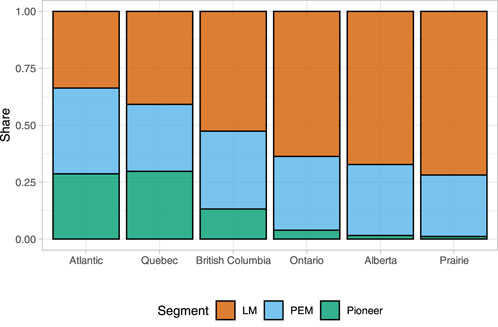
Figure 1. Market segments: by region. Source: Authors’ calculations from Canadian Home Heating Survey.
The distribution of PEMs across the country is more equal, with their share ranging from 27% in the Prairies to 37.7% in Atlantic Canada. This suggests that heat pump adoption is feasible in all regions of the country. With an overall PEM share of 31.8%, reaching the 2030 goal of 10.5% in Canada’s ERP appears to be feasible. In order to reach the 2050 upper range of 68% market share for heat pumps it will be necessary to convert some LMs into heat pump owners. The overall LM share is 55% and it is highest in the Prairies, Alberta and Ontario with shares of 71.9%, 67.3% and 63.7% respectively.
5.2 Personal capability variables
The first subset of variables from the ABC model that we consider are personal capability variables. The results of our ordered logistic regression model for these variables are shown in Table 4. The personal capability variables considered are gender, age, education, income, household size, urban-rural status, and whether the individual is a regular voter. The first seven columns of Table 4 look at each category of variable individually while column eight is a multiple regression that captures all variables simultaneously.
Due to instances of missing data the sample size for these regressions is 3,337. We report the residual deviance for all models considered in this paper. The residual deviance is
We find that the relationship between females and market segments is negative. This means that females are less likely to be Pioneers. Robustness analysis indicated that females are more likely to select “I don’t know” in the survey for whether they would adopt heat pump technology, thus classifying them as LMs. The results in column 1 are consistent with findings for British Columbia in Pardy et al. (2022). Future research could explore why being female is associated with lower willingness to adopt heat pumps, potentially accounting for associations between gender and other explanatory variables.
When looking at age independently of other personal capability variables only 55–64 year olds are less likely than the reference group to be Pioneers. However, after conditioning in column 7, we find that all respondents over 45 have negative coefficients. This finding is consistent with zero-emission vehicle research, where being younger is associated with a preference for pro-environmental technology (Kormos et al., 2019).
Education and income are both positively associated with market segment, both conditionally and unconditionally, as found in other research comparing Pioneers to other market segments for other pro-environmental technologies (Michelsen and Madlener, 2012; Tal and Nicholas, 2013; Plötz et al., 2014). These results combined suggest that younger, educated, higher income individuals are most likely to adopt heat pumps. The high up-front cost of installing a heat pump could serve as a deterrent for low-income households, even in cases where the net-present value of the investment is positive.
Individuals who vote regularly and live in rural areas are positively associated with market segmentation. These results are consistent with the findings in Pardy et al. (2022). What is new in our study is the finding that, even after conditioning on other personal capability variables, voting and rural status are strongly significant predictors of willingness to install a heat pump. Past research in the Canadian context finds that rural provinces are more likely to have higher voter turnout (Siaroff and Wesly, 2015). Our rural/urban location finding is different from that typically found in zero-emission vehicle research: those willing to purchase zero-emission tend to be more urban than rural (Axsen et al., 2016). Rural areas are less likely to be connected to a natural gas grid, meaning that heating oil is common. This could increase the incentive to switch to a heat pump given relatively higher expenses associated with heating a home through oil.
5.3 Contextual variables
Table 5 presents the ordered logistic regression results for the contextual variables included in our analysis. Column 9 is our preferred specification. Looking at the residual deviance, this model provides the best fit of the data.
Many contextual variables are found to be statistically significant predictors of market segments. Both detached and newer homes are most likely to be associated with Pioneers and PEMs as had been found in previous research (Meles et al., 2019; Troiano et al., 2019; Pardy et al., 2022). This is intuitive because owners of detached homes likely have less restrictions on home retrofits due to strata or condominium rules. They also have higher home heating bills. Newer homes are more likely to already have ASHPs installed as the technology was not available when older housing stock was built. This likely explains why homes built after the year 2000 are shown to be more likely to be Pioneers and PEMs.
The existing primary energy source for heat is significant indicator of market segments. Relative to natural gas, individuals who use electricity and oil to heat their homes are more likely to be Pioneers or PEMs. This finding is relevant in the context of the current debate around carbon taxation on home heating fuels in Canada. An analysis by the Canadian Climate Institute (2023a) finds that the emissions increase from the oil carve-out are small in 2030 at 0.1 MtCO2e. This is in contrast to the effect of a potential natural gas carve-out which is 4.5 MtCO2e. One reason for this, which is clear from our results, is that, even in the absence of a carbon price, households who use heating oil or baseboard heating in general exhibit willingness to switch to a heat pump.
Homeowners who do not have air conditioning are more likely to be PEMs. This speaks to the dual role of ASHPs as a heating and cooling technology. ASHPs have an important role to play in resilience to extreme heat, one of the impacts of climate change that is already occurring. This is particularly important in regions of the country with mild climates that do not typically have air conditioning as part of the historical building stock. The 2021 British Columbia heatwave was an example of a deadly extreme weather event that could have been mitigated through more access to air conditioning (Canadian Climate Institute 2023b).
It is noteworthy that home size, connection to the natural gas grid and provincial electricity prices are not significant at the 5% level, and in the case of electricity prices, not at all. Pardy et al. (2022) found that Pioneers were more likely to live in larger homes than the PEM or LM. Our a priori assumption was that these would be important factors for determining market segments. They appear to be secondary to home heating fuel energy type.
5.4 Attitudinal variables
Table 6 presents our regression results for the attitudinal variables. Note that unlike prior regression tables that mostly had dummy independent variables, the variables in this table are measured as quantitative scores. Environmental-oriented and technology-oriented lifestyles are valued from 0-4, while trust in the renewables industry is scored from 1-4, and openness to change is scored 1-5.
We find that all attitudinal variables are statistically significant, both in single variable regressions as well as in Column 5 where we have included all variables at the same time. These findings align closely with those found in Pardy et al. (2022). Environmental- and technology-oriented lifestyles have been found to be associated with preferences for zero-emission vehicles (Kormos et al., 2019; Long et al., 2019). Those exhibiting technology-oriented lifestyles are likely interested in testing out the latest technologies. While heat pumps have been around for many years, they can still be considered emerging technologies in North America, thus potentially drawing the interest of technology-oriented individuals.
Openness to change is a value often related to technology-oriented lifestyles. In the context of zero-emission vehicles, Axsen et al. (2016) found that the LM scored lower than Pioneers and the PEM on average. Being less technology-oriented and less open to change in general, LM households may be more wary of perceived risks of new home heating systems as well as any changes to their home necessary for heat pump installation and operation.
5.5 Geographic variation
Column 5 of Table 7 presents comprehensive results that include dummy variables for geographic regions as well as all personal capability, contextual and attitudinal variables analyzed in this paper. Column 1 fits a model with only geographic dummies and Columns 2 to 4 look at the personal capability, contextual, and attitudinal variables in isolation.
We include the number of parameters and the AIC model selection criterion for ease of model comparison. Both the AIC criterion and likelihood ratio tests, significant at the 1% level, lead us to choose Column 5 as our preferred model. Our conclusion is that personal capability, contextual, attitudinal, and geography are informative for characterizing market segments. Leaving any of these factors out of an analysis of market segments would result in a loss of relevant information. This result can be viewed as a test of the ABC theory presented in Stern (2000) in the context of heat pump market segments in Canada.
It is instructive that geography is a significant predictor of heat pump market segments in all models. Given the variety and number of variables included in this analysis this result is very striking. It suggests that, even after controlling for a variety of other factors, there is something specific to provinces and regions that determines market segments. Future research could use this methodology to determine if there are additional contextual factors that drive regional variation. Two candidates could be policy regimes and climate. Some provinces, such as British Columbia, have a history of heat pump-supportive policies such as subsidies, rebates, and information campaigns. It is reasonable to believe that over time, these policies might have primed the public to be more supportive of the technology.
Climate, combined with current energy infrastructure, likely plays a role as well. British Columbia and parts of the Maritimes have relatively mild climates compared to the rest of the country, long making them suitable locations for heat pump installations. The Atlantic provinces have the additional factor of traditionally relying on expensive heating oil, potentially making other heating options more attractive.
Alberta, the Prairies, and Ontario experience very cold winters. Older heat pump technologies were not equipped to handle extreme winter temperatures on their own, requiring separate (and costly) back-up systems. These three regions also have robust natural gas networks, leaving gas-powered furnaces and boilers as relatively inexpensive home heating options.
Table 7 makes it clear that the contextual variables have the largest impact on model interpretation. This is apparent from its residual deviance, which is lowest among all models except for the combined one in Column 5. It is also noteworthy that controlling for contextual factors impacts the magnitude of the coefficients for Quebec and British Columbia. Relative to a case where no contextual factors are controlled for, British Columbians are more likely to be open to heat pump adoption once contextual factors are controlled for while Quebeckers are less likely. Given that some contextual factors could be influenced by policy, this is an interesting result.
6 Conclusion
Heat pumps are currently in the early adoption phase in Canada. Our study suggests that early adopters (Pioneers) are concentrated primarily in Eastern Canada (Quebec and Atlantic provinces) whereas potential adopters (PEMs) are more equally distributed across the country implying that heat pump adoption is possible and can be increased in all regions of Canada.
The application of the ABC theoretical framework via ordered logistic regressions provides powerful insights into the key characteristics of heat pump market segments. In terms of personal capability descriptors, being younger, more educated and wealthier is positively associated with market segmentation in Canada. When controlling for other personal capability variables, we find that voting and living in rural areas is strongly associated with willingness to install a heat pump—a novel finding in the field of pro-environmental technology adoption. The finding implies that heat pump incentives could be increased in rural areas that are highly dependent on heating oil rather than natural gas and therefore currently have higher heating expenses. In regards to personal attitudes, those with technology- and environment-oriented lifestyles, high trust in the renewable industry and openness to change values are more inclined to adopt a heat pump, in line with our expectations and past research.
We find that many contextual variables matter in heat pump market segmentation both on their own and when controlling for personal capability and attitudinal variables. Pioneers and PEMs are more likely to live in detached and newer homes possibly due to the ability to freely retrofit their homes and relaxed or no condominium rules. The energy source for heating is also an important characteristic of early and potential adopters—those who use electricity and oil rather than natural gas are more likely to adopt a heat pump consistent with our finding that rural residents have higher willingness to switch to heat pumps. Homeowners without air conditioning are also more likely to become potential adopters emphasizing the cooling co-benefit of heat pumps.
Lastly, we find that geographic location has a strong significant association with heat pump market segmentation even when controlling for all other variables in the ABC model. Provinces with heat pump supportive policies, lower electricity rates, and milder climates are more likely to adopt heat pumps. This suggests the need to continue expanding existing subsidies, loans and information campaigns coupled with enforcing policies such as carbon pricing and regulations, to push the technology into the deployment phase across the entire country.
Our study has several limitations. While the Canada-wide sample is large and representative of the entire population of homeowners, provincial level sample sizes are relatively small to claim representativeness in each region. Future research could oversample provinces of interest to study geography-specific characteristics of heat pump adoption identified in our regression analyses. Second, we study adoption of air source heat pumps only. While they are a dominant technology at the moment, ground source heat pumps are popular in other jurisdictions, especially in cold climates, and therefore could become more prevalent in Canada. Future research into the ground source technology is required. Further, we focus on homeowners that own and live in their detached or semi-detached homes, ignoring renters and condominium owners. Future research could expand the sample size in this regard, potentially assessing household perceptions of multi-story building-scale or even district-scale heat pump installations for apartment buildings.
Future research could take a more policy-focused approach in the analysis of market segmentation. Government policy is major unit of analysis in the contextual variable category of ABC theory (Stern, 2000). Although recent research shows that homeowners show little awareness of government policy aimed at promoting the adoption of heat pumps, it could be interesting to see if this variable differs between heat pump owners and non-owners (Corbett et al., 2023). In future work, the presence of specific policy instruments could be included as contextual variables in the ABC framework. Similarly, respondent knowledge of specific implemented policies could be included as contextual variables.
Finally, our study is based on associations and not causation. Future experimental designs could use randomization to facilitate causal research designs.
Despite these limitations, our study offers important contributions to the emerging academic literature on heat pump adoption and residential climate-policy making. Our study is the first to apply a wide range of personal capability, attitudinal, and contextual characteristics to understand heat pump market segments at a national level using a large representative sample of homeowners. The exploration of the role of these variables across early, potential, and late adopters suggests further needs to maintain and expand heat pump supportive policies until technology market shares increase substantially to drive cost-minimizing market-based decisions.
Data availability statement
The raw data supporting the conclusion of this article will be made available by the authors, upon request.
Ethics statement
The studies involving humans were approved by the Research Ethics BC—University of Victoria and Simon Fraser University. The study was conducted in accordance with the local legislation and institutional requirements. The participants provided their written informed consent to participate in this study.
Author contributions
KA: Conceptualization, Data curation, Formal Analysis, Investigation, Methodology, Software, Visualization, Writing–original draft. AP: Conceptualization, Methodology, Validation, Writing–review and editing, Resources. ER: Conceptualization, Funding acquisition, Project administration, Resources, Supervision, Validation, Writing–review and editing.
Funding
The authors declare that financial support was received for the research, authorship, and/or publication of this article. This research is funded by the Social Sciences and Humanities Research Council Insight Development Grant # 430-2020-00214 and the Pacific Institute for Climate Solutions (PICS).
Acknowledgments
We would like to acknowledge the Social Sciences and Humanities Research Council of Canada and the Pacific Institute for Climate Solutions (PICS) for supporting this research.
Conflict of interest
The authors declare that the research was conducted in the absence of any commercial or financial relationships that could be construed as a potential conflict of interest.
Publisher’s note
All claims expressed in this article are solely those of the authors and do not necessarily represent those of their affiliated organizations, or those of the publisher, the editors and the reviewers. Any product that may be evaluated in this article, or claim that may be made by its manufacturer, is not guaranteed or endorsed by the publisher.
Supplementary material
The Supplementary Material for this article can be found online at: https://www.frontiersin.org/articles/10.3389/fenef.2024.1376070/full#supplementary-material
References
Axsen, J., Bailey, J., and Castro, M. A. (2015). Preference and lifestyle heterogeneity among potential plug-in electric vehicle buyers. Energy Econ. 50, 190–201. doi:10.1016/j.eneco.2015.05.003
Axsen, J., Goldberg, S., and Bailey, J. (2016). How might potential future plug-in electric vehicle buyers differ from current "Pioneer" owners? Transp. Res. Part D Transp. Environ. 47, 357–370. doi:10.1016/j.trd.2016.05.015
Axsen, J., and Kurani, K. S. (2012). Social influence, consumer behavior, and low-carbon energy transitions. Annu. Rev. Environ. Resour. 37, 311–340. doi:10.1146/annurev-environ-062111-145049
Axsen, J., and Kurani, K. S. (2013). Connecting plug-in vehicles with green electricity through consumer demand. Environ. Res. Lett. 8, 014045. doi:10.1088/1748-9326/8/1/014045
Billimoria, S., Guccione, L., Henchen, M., and Louis-Prescott, L. (2018). The economics of electrifying buildings: how electric space and water heating supports decarbonization of residential buildings.
Black, J. S., Stern, P. C., and Elworth, J. T. (1985). Personal and contextual influences on househould energy adaptations. J. Appl. Psychol. 70, 3–21. doi:10.1037/0021-9010.70.1.3
Braun, F. G. (2010). Determinants of households' space heating type: a discrete choice analysis for German households. Energy Policy 38, 5493–5503. doi:10.1016/j.enpol.2010.04.002
Canadian Climate Institute (2021). Canada's net zero future: finding our way in the global transition. Ottawa, Canada: Canadian Institute for Climate Choices. https://climatechoices.ca/wp-content/uploads/2021/02/Canadas-Net-Zero-Future_FINAL-2.pdf (Accessed July 20, 2022).
Canadian Climate Institute (2023a). “The case for adapting to extreme heat: costs of the 2021 B.C. heat wave,” in White paper, Canadian Climate Institute.
Canadian Climate Institute (2023b). Heat pumps pay off: unlocking lower-cost heating and cooling in Canada. Ottawa, Canada: Canadian Climate Institute.
Canadian Climate Institute (2023c). New analysis: removing carbon price from gas heating would increase emissions and leave Canadians worse off. https://climateinstitute.ca/removing-carbon-price-increase-emissions-canadians-worse-off/(Accessed January 14, 2024).
Corbett, M., Rhodes, E., Pardy, A., and Long, Z. (2023). Pumping up adoption: the role of policy awareness in explaining willingness to adopt heat pumps in Canada. Energy Res. Soc. Sci. 96, 102926. doi:10.1016/j.erss.2022.102926
Dahlstrand, U., and Biel, A. (1997). Pro-environmental habits: propensity levels in behavioral change. J. Appl. Soc. Psychol. 27, 588–601. doi:10.1111/j.1559-1816.1997.tb00650.x
Dietz, T., Fitzgerald, A., and Shwom, R. (2005). Environmental values. Annu. Rev. Environ. Resour. 30, 335–372. doi:10.1146/annurev.energy.30.050504.144444
ECCC (2022). 2030 emissions reduction plan: Canada's next steps for clean air and a strong economy. Ottawa, Canada: Environment and Climate Change Canada. https://www.canada.ca/en/services/environment/weather/climatechange/climate-plan/climate-plan-overview/emissions-reduction-2030/plan.html (Accessed July 20, 2022).
Energy Hub (2023). Electricity prices in Canada 2023. https://www.energyhub.org/electricity-prices/(Accessed January 14, 2024).
Franceschinis, C., Thiene, M., Scarpa, R., Rose, J., Moretto, M., and Cavalli, R. (2017). Adoption of renewable heating systems: an empirical test of the diffusion of innovation theory. Energy 125, 313–326. doi:10.1016/j.energy.2017.02.060
Guagnano, G. A., Stern, P. C., and Dietz, T. (1995). Influences on attitude-behavior relationships: a natural experiment with curbside recycling. Environ. Behav. 27 (5), 699–718. doi:10.1177/0013916595275005
He, Z., Zhou, Y., Wang, J., Li, C., Wang, M., and Li, W. (2021). The impact of motivation, intention, and contextual factors on green purchasing behavior: new energy vehicles as an example. Bus. Strategy Environ. 30 (2), 1249–1269. doi:10.1002/bse.2682
Heffner, R. R., Kurani, K. S., and Turrentine, T. S. (2007). Symbolism in California's early market for hybrid electric vehicles. Transp. Res. Part D Transp. Environ. 12 (6), 396–413. doi:10.1016/j.trd.2007.04.003
Karytsas, S., and Theodoropoulou, H. (2014). Public awareness and willingness to adopt ground source heat pumps for domestic heating and cooling. Renew. Sustain. Energy Rev. 34, 49–57. doi:10.1016/j.rser.2014.02.008
Kitt, S., Axsen, J., Long, Z., and Rhodes, E. (2021). The role of trust in citizen acceptance of climate policy: comparing perceptions of government competence, integrity and value similarity. Ecol. Econ. 183, 106958. doi:10.1016/j.ecolecon.2021.106958
Kormos, C., Axsen, J., Long, Z., and Goldberg, S. (2019). Latent demand for zero-emissions vehicles in Canada (Part 2): insights from a stated choice experiment. Transp. Res. Part D Transp. Environ. 67, 685–702. doi:10.1016/j.trd.2018.10.010
Lang, G., Farsi, M., Lanz, B., and Weber, s. (2021). Energy efficiency and heating technology investments: manipulating financial information in a discrete choice experiment. Resour. Energy Econ. 64, 101231. doi:10.1016/j.reseneeco.2021.101231
Long, Z., Axsen, J., Kormos, C., and Goldberg, S. (2019). Latent demand for zero-emissions vehicles in Canada (Part 1): insights from a design space exercise. Transp. Res. Part D Transp. Environ. 67, 51–66. doi:10.1016/j.trd.2018.10.009
Mahapatra, K., and Gustavsson, L. (2009). Influencing Swedish homeowners to adopt district heating system. Appl. Energy 86, 144–154. doi:10.1016/j.apenergy.2008.03.011
Major, D. (2023). Ottawa exempting home heating oil from carbon tax for 3 years, Trudeau says. Ottawa, Canada: Canadian Broadcasting Corporation. https://www.cbc.ca/news/politics/trudeau-pause-carbon-tax-rural-home-heating-1.7009347 (Accessed January 13, 2024).
Meles, T. H., Ryan, L., and Mukherjee, S. C. (2019). Heterogeneity in preferences for renewable home heating systems. Working Paper. Dublin: University College Dublin Working Paper Series.
Michelsen, C. C., and Madlener, R. (2012). Homeowners' preferences for adopting innovative residential heating systems: a discrete choice analysis for Germany. Energy Econ. 34, 1271–1283. doi:10.1016/j.eneco.2012.06.009
Natural Resources Canada (2023). Table 27: heating system stock by building type and heating system type. https://oee.nrcan.gc.ca/corporate/statistics/neud/dpa/showTable.cfm?type=CP§or=res&juris=ca&rn=27&page=0 (Accessed January 13, 2024).
Nie, C., and Zepeda, L. (2011). Lifestyle segmentation of US food shoppers to examine organic and local food consumption. Appetite 57, 28–37. doi:10.1016/j.appet.2011.03.012
Odland, S., Rhodes, E., Corbett, M., and Pardy, A. (2023). What policies do homeowners prefer for building decarbonization and why? An exploration of climate policy support in Canada. Energy Policy 173, 113368. doi:10.1016/j.enpol.2022.113368
Palm, A. (2020). Early adopters and their motives: differences between earlier and later adopters of residential solar photovoltaics. Renew. Sustain. Energy Rev. 133, 110142. doi:10.1016/j.rser.2020.110142
Pardy, A., Rhodes, E., and Jaccard, M. (2022). Characterizing air source heat pump market segments: a Canadian case study. Front. Sustain. 3. doi:10.3389/frsus.2022.983454
Plötz, P., Schneider, U., Globisch, J., and Dütschke, E. (2014). Who will buy electric vehicles? identifying early adopters in Germany. Transp. Res. A Policy Pract. 67, 96–109. doi:10.1016/j.tra.2014.06.006
Rhodes, E., Axsen, J., and Jaccard, M. (2014). Does effective climate policy require well-informed citizen support? Glob. Environ. Change 29, 92–104. doi:10.1016/j.gloenvcha.2014.09.001
Rhodes, E., Axsen, J., and Jaccard, M. (2015). Gauging citizen support for a low carbon fuel standard. Energy Policy 79, 104–114. doi:10.1016/j.enpol.2015.01.019
Rhodes, E., Axsen, J., and Jaccard, M. (2017). Exploring citizen support for different types of climate policy. Ecol. Econ. 137, 56–69. doi:10.1016/j.ecolecon.2017.02.027
Siaroff, A., and Wesley, J. J. (2015). Comparative voter turnout in the Canadian provinces since 1965: the importance of context. Can. Political Sci. Rev. 9 (1), 147–163. doi:10.24124/c677/20151206
Statistics Canada (2021). Census Profile, 2021 Census of Population. Retrieved from: https://www12.statcan.gc.ca/census-recensement/2021/dp-pd/prof/index.cfm?Lang=E.
Stern, P. C. (2000). New environmental theories: toward a coherent theory of environmentally significant behavior. J. Soc. Issues 56, 407–424. doi:10.1111/0022-4537.00175
Tal, G., and Nicholas, M. A. (2013). Studying the PEV market in California: comparing the PEV, PHEV and hybrid markets. World electric vehicle symposium and exhibition (EVS27). https://d1wqtxts1xzle7.cloudfront.net/40189295/Studying_the_PEV_Market_in_California_Co20151119-2437-qqltk6-libre.pdf?1447988625=&response-content-disposition=inline%3B+filename%3DStudying_the_PEV_market_in_california_Co.pdf&Expires=1705189495&Signature=Q.
Troiano, S., Vecchiato, D., Marangon, F., Tempesta, T., and Nassivera, F. (2019). Households' preferences for a new 'climate-friendly' heating system: does contribution to reducing greenhouse gases matter? Energies 12, 2632. doi:10.3390/en12132632
Willis, K., Scarpa, R., Gilroy, R., and Hamza, N. (2011). Renewable energy adoption in an ageing population: heterogeneity in preferences for micro-generation technology adoption. Energy Policy 39, 6021–6029. doi:10.1016/j.enpol.2011.06.066
Wilson, C., Pettifor, H., and Chryssochoidis, G. (2018). Quantitative modelling of why and how homeowners decide to renovate energy efficiently. Appl. Energy 212, 1333–1344. doi:10.1016/j.apenergy.2017.11.099
Wooldridge, J. M. (2010). Econometric analysis of cross section and panel data. Cambridge, Massachusetts: The MIT Press.
Nomenclature
Keywords: heat pumps, market segmentation, residential buildings, climate policy, attitude-behavioral-context framework
Citation: Andrew K, Pardy A and Rhodes E (2024) The landscape of heat pump adoption in Canada: a market segments approach. Front. Energy Effic. 2:1376070. doi: 10.3389/fenef.2024.1376070
Received: 24 January 2024; Accepted: 14 March 2024;
Published: 09 April 2024.
Edited by:
Orhan Ekren, Cranfield University, United KingdomCopyright © 2024 Andrew, Pardy and Rhodes. This is an open-access article distributed under the terms of the Creative Commons Attribution License (CC BY). The use, distribution or reproduction in other forums is permitted, provided the original author(s) and the copyright owner(s) are credited and that the original publication in this journal is cited, in accordance with accepted academic practice. No use, distribution or reproduction is permitted which does not comply with these terms.
*Correspondence: Aaron Pardy, apardy@sfu.ca
 Kevin Andrew
Kevin Andrew Aaron Pardy
Aaron Pardy Ekaterina Rhodes
Ekaterina Rhodes